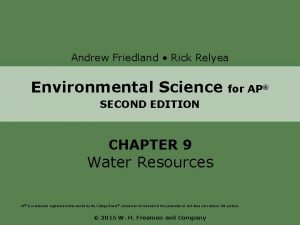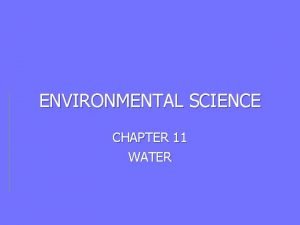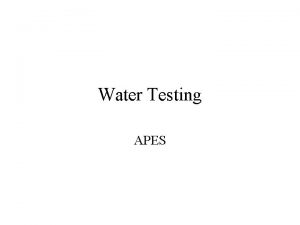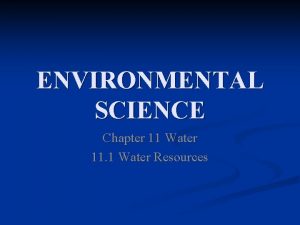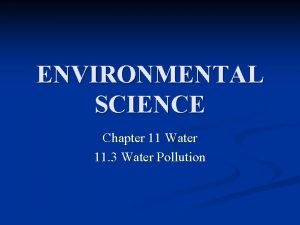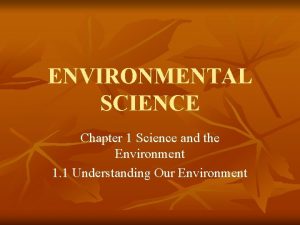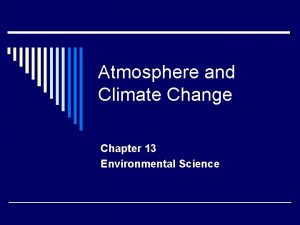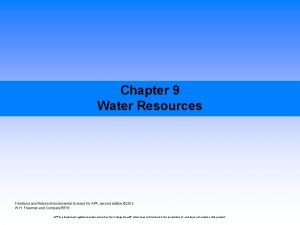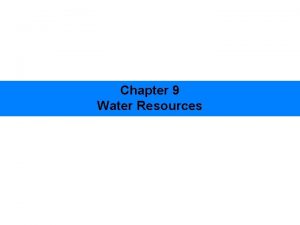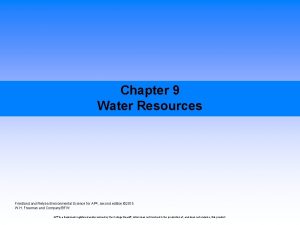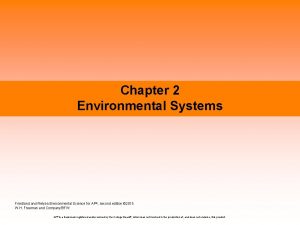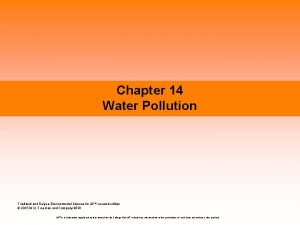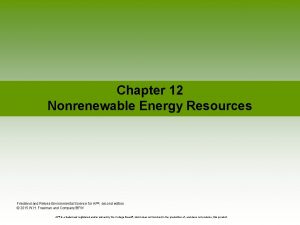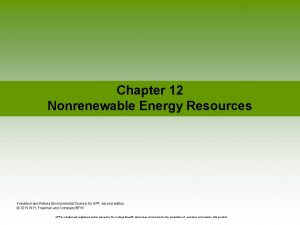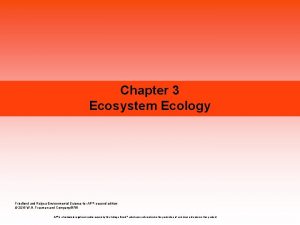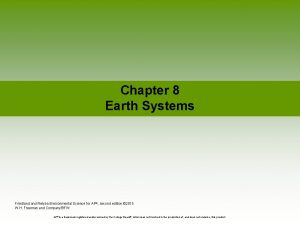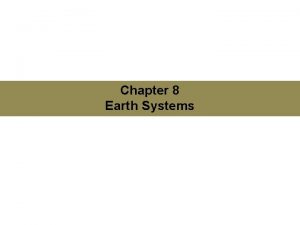Chapter 9 Water Resources Friedland Relyea Environmental Science














- Slides: 14

Chapter 9 Water Resources Friedland Relyea Environmental Science for AP®, second edition © 2015 AP® is a trademark registered and/or owned by the College Board ®, which was not involved in the production of, and does not endorse, this product.

Module 26 The Availability of Water After reading this module you should be able to • Describe the major sources of groundwater. • Identify some of the largest sources of fresh surface water. • Explain the effects of unusually high and low amounts of precipitation.

Groundwater can be extracted for human use Distribution of water on Earth. Fresh water represents less than 3 percent of all water on Earth, and only about three-fourths of that fresh water is surface water. Most of that surface water is frozen as ice and in glaciers. Therefore, less than 1 percent of all water on the planet is accessible for use by humans.

Groundwater • Aquifer A permeable layer of rock and sediment that contains groundwater. • Unconfined aquifer An aquifer made of porous rock covered by soil out of which water can easily flow. • Confined aquifer An aquifer surrounded by a layer of impermeable rock or clay that impedes water flow.

Groundwater Aquifers are sources of usable groundwater. Unconfined aquifers are rapidly recharged by water that percolates downward from the land surface. Confined aquifers are capped by an impermeable layer of rock or clay, which can cause water pressure to build up underground. Artesian wells are formed when a well is drilled into a confined aquifer and the natural pressure causes water to rise toward the ground surface.

Groundwater • Water table The uppermost level at which the water in a given area fully saturates rock or soil. • Groundwater recharge A process by which water percolates through the soil and works its way into an aquifer. • Spring A natural source of water formed when water from an aquifer percolates up to the ground surface. • Artesian well A well created by drilling a hole into a confined aquifer.

Groundwater The Ogallala aquifer, also called the High Plains aquifer, is the largest in the United States, with a surface area of about 450, 000 km 2 (174, 000 miles 2). (a) The change in water level from 1950 to 2005, mostly due to withdrawals for irrigation that have exceeded the aquifer’s rate of recharge. (b) The current thickness of the aquifer.

Groundwater • Cone of depression An area lacking groundwater due to rapid withdrawal by a well. • Saltwater intrusion An infiltration of salt water in an area where groundwater pressure has been reduced from extensive drilling of wells.

Groundwater Cone of depression. (a) When a deep well is not heavily pumped, the recharge of the water table keeps up with the pumping. (b) In contrast, when a deep well pumps water from an aquifer more rapidly than it can be recharged, it can form a cone of depression in the water table and cause nearby shallow wells to go dry.

Groundwater Saltwater intrusion. (a) When there are few wells along a coastline, the water table remains high and the resulting pressure prevents salt water from intruding. (b) Rapid pumping of wells drilled in aquifers along a coastline can lower the water table. Lowering the water table reduces water pressure in the aquifer, allowing the nearby salt water to move into the aquifer and contaminate the well water with salt.

Surface water is the collection of aquatic biomes • Surface water is water that exists aboveground and includes steams, rivers, ponds, and wetlands. • Early human civilizations typically settled along major rivers. • Floodplain-The land adjacent to a river.

Surface Water The world’s largest lakes. Measurements of surface area, depth, and volume are shown for each lake.

Atmospheric water produces precipitation • Although the atmosphere contains only a very small percentage of the water on Earth, that atmospheric water is essential to global water distribution. • Impermeable surface Pavement or buildings that do not allow water penetration.

Where we get our fresh water? • Lets Find Out!
 Friedland and relyea environmental science
Friedland and relyea environmental science Rick relyea
Rick relyea Heather friedland
Heather friedland Medienkonzepte friedland
Medienkonzepte friedland Water and water and water water
Water and water and water water Water that contains waste from homes or industry
Water that contains waste from homes or industry Tds apes
Tds apes Water table environmental science
Water table environmental science Rule of 70 in population growth
Rule of 70 in population growth What is your favorite lesson
What is your favorite lesson Introduction of water pollution
Introduction of water pollution Environmental science chapter
Environmental science chapter Chapter 13 review environmental science
Chapter 13 review environmental science Chapter 19 environmental science
Chapter 19 environmental science Chapter 2 economics and environmental policy
Chapter 2 economics and environmental policy
